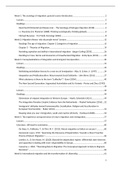Week 1: The sociology of migration: general course introduction.........................................................2
Lecture................................................................................................................................................2
Readings.............................................................................................................................................4
David Scott FitzGerald and Rawan Arar – The Sociology of Refugee Migration (2018)...................4
J.J. Macionis & K. Plummer (2008). Thinking sociologically, thinking globally................................6
Michael Burawoy – For Public Sociology (2004).............................................................................8
Week 2: Migration theory: why do people move? Lecture..................................................................13
Readings The age of migration: Chapter 2 Categories of migration.............................................15
Chapter 3 – Theories of Migration................................................................................................19
Revisiting aspiration and ability in international migration - Jørgen Carling (2018)......................26
Deciding to Cross: Norms and Economics of Unauthorized Migration - Emily Ryoa (2013)..........29
Week 3: Conceptualizations of integration and immigrant incorporation............................................30
Lecture..............................................................................................................................................31
Readings...........................................................................................................................................34
Rethinking assimilation theory for a new era of immigration - Alba, R. & Nee, V. (1997)............34
Integration and Multiculturalism: Ways towards Social Solidarity – John Berry (2011)...............37
What substance is there to the term “Leitkultur”? -Esser (2004).................................................40
The New Second Generation: Segmented Assimilation and Its Variants –Portes and Zhou (1993)
......................................................................................................................................................42
Lecture..............................................................................................................................................44
Readings...........................................................................................................................................49
Dimensions of migrant integration in Western Europe. - Heath, Schneider (2021)......................49
The integration Paradox: Empiric Evidence from the Netherlands – Maykel Verkuyten (2016)...52
Immigrants’ attitudes toward homosexuality: Socialization, Religion and Acculturation in
European Host Societies – Roder (2014).......................................................................................54
Reaping what you sow: immigration, youth and reactive ethnicity – Rumbaut (2008)................56
Week 5: The experience and governance of return migration and reintegration................................57
Lecture..............................................................................................................................................57
Literature still need to summarize...................................................................................................60
De Haas, H., Fokkema, T., & Fihri, M. F. (2015). Return migration as failure or success?.............60
Hammond, Laura. 1999. "Examining the Discourse of Repatriation: Towards a More Proactive
Theory of Return Migration.".......................................................................................................60
Leerkes, A., & Van Houte, M. (2020). Beyond the deportation regime: differential state interests
and capacities in dealing with (non-) deportability in Europe......................................................60
Cassarino, J. 2004. "Theorising Return Migration: The Conceptual Approach to Return Migrants
Revisited.".....................................................................................................................................60
Week 6: International migration and the transformation of citizenship..............................................61
1
, Lecture..............................................................................................................................................61
Literature..........................................................................................................................................64
Transformation of Citizenship: Status, Rights, Identity – Joppke (2007).......................................64
“Towards Post-National and Denationalized Citizenship. - Sassen, (2002)..................................65
Managing contradiction: Civic stratification and migrants’ rights - Morris, L. (2003)...................67
Week 1: The sociology of migration: general
course introduction
Lecture
This lecture positions the sociology of migration within the broader discipline of sociology.
2
,What is sociology?
At some point a structure arrives that transcends the individual (artwork on height, London)
How do structures emerge from individual?
How do structure relates to other structure?
How do these individual structures influence who we are, how we behave, socialize?
Some definitions given by sociologist:
- Study of society
- The scientific study of social aggregations, the entities through which humans move
throughout their lives
- The study of our behaviour as social being.
- (some sociologists also see sociology as an overarching unification of all studies of
humankind)
It does so by relating the field to the three times sociology in fourfold:
The four main sociological problems:
o Cohesion: what keeps societies together?
o Inequality: who gets what and why?
o Modernisation/ rationalisation: (19th century) What explains social change? Emphasis
on instrumental rationality
o (social) Identity: how do our memberships in groups influence what we do?
Cohesion Durkheim: Cohesion 1 peace and violence, 2 attachment and isolation and Jong-
Gierveld en Dykstra: cohesion attachment and isolation 1 more private
Inequality: (Marx) class struggle between privileged and not so privileged; focussing on structure and
consciousness. Looking at process of stratification : size of strata and what is openness of strata
Modernisation: traditional to a capitalist economy, the rise of science, the bureaucratization of the
state always follow the rules. Globalization: The chains of dependency become longer is part of
Rationalization process welfare state
Identity: how we see ourself and how others see us
These are just examples of what is researched
The four main theoretical traditions:
o Functionalism: (Durkheim) explain phenomena in relation to the whole. It focuses
not so much on change
o Conflict theory: (Marx, Foucault, feminism), macro focus, false consensus because it
derives from the dominant group. Conflict theory are more critical
o Symbolic interactionism: focus on individual actors; presumes that actors does what
is appropriate to do in certain situations.
o Rational choice theory: derives from economics and political sciences: cost benefit
usually seen as to cold and rational, they aren’t rational
The four main objectives of sociological enquiry: (see Burroway)
o Theory formation
o Policy evaluation
o Public debate
3
, o Critical academic reflection
Hierarchy: professional, policy and then marginal is critical and public
Social will look at social phenomenon apart from policies and interactions with sociology
Academic audience Extra-academic audience
Empirical- theoretical Professional Policy
normative Critical Public
It also discusses the four main questions of the sociology of migration:
How are categories of migration socially constructed? (e.g., the distinction between
‘voluntary migrants’ and ‘forced refugees’)
Why do people migrate?
How do migrants and people of migrant heritage become part of receiving societies?
How do societies change under the influence of human migration?
Get structure slide! first three questions are being discussed by Fitzgerald
Sociology & History:
- stronger focus on present
- Larger palette of research methods
- Stronger theoretical focus, instead of more descriptive
Sociology & PA
- multidisciplinary, (law, economics, political science, sociology)
- Soc has more extra-academic public and a stronger critical element
- Soc: policy is just one social force
Sociology & Development studies
- development studies is multidisciplinary
- stronger focus on western societies, is problematic, would these theories apply to other countries
- ISS; more qualitative research methods
Readings
David Scott FitzGerald and Rawan Arar – The Sociology of
Refugee Migration (2018)
Abstract: Theorization in the sociology of migration and the field of refugee studies has been
retarded by a path-dependent division that we argue should be broken down by greater mutual
engagement. Excavating the construction of the refugee category reveals how unwarranted
assumptions shape contemporary disputes about the scale of refugee crises, appropriate policy
responses, and suitable research tools. Empirical studies of how violence interacts with economic and
4





